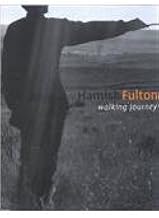Hamish Fulton: Walking Journey edited by Ben Tufnell 2002
There are two wonderful prints by a British artist, Hamish Fulton, on the walls of my study in Cambridge. One shows the 22 walks that Fulton made in England and Ireland over a period of 20 years. The other shows the outline of a walk Fulton made in Nepal in 2005. I bought them at the Krakow-Witkin Gallery in Boston several years ago, and when I walk into that room, I am both delighted and amazed when I think about Fulton’s vision, strength, and talent in translating those evanescent, physically taxing experiences onto paper for me to experience years later.
This book is the catalogue from the one-man exhibition of Fulton’s work at the Tate Britain in 2002. Comprising a foreward by the Tate Director, an introduction by Fulton’s editor, a critical appraisal of his work by Andrew Wilson, introductory essays by the Vermont environmentalist Bill McKibben and the mountaineer Doug Scott, and an interview with Fulton by Ben Tufnell, the major part of the catalogue are reproductions of Fulton’s works.
The works are primarily photographs from his walks with word texts superimposed on the images. There are also depictions of walks using various materials including pieces of wood, ribbons,and clothes pins. The photographs occasionally include people, but are primarily a record of stones, milestone markers, clouds, lakes, paths, and other topographical features of the walks which are also recorded with a summary of the days, nights, beginning and end of the walk, the distance travelled, and notable times such as solstice dates and full moons. The walks were made all over the world including Peru, Bolivia, Scotland, Canada, England, Spain, Germany, Nepal, Tibet, and perhaps most significantly the Dakotas and Montana where he followed his deep interest in the American Indian.
Fulton, born in 1946, has over the years been categorized as a land artist, a minimalist, a Conceptual artist, a sculptor, a photographer, a word artist, and, in reality, he is in some aspects of his work all of the above. Fundamentally, however, the work of art is the walk, not its representation in photos or words. The walk exists in time and place, and when it is completed, it no longer exists. It is this sense of place and time, measured and experienced, present and evanescent, that Fulton captures much in the same way that Kawara captures time and space in his Date Paintings and postcards.
Trying to describe Fulton’s work as beautifully depicted in this catalogue is a bit like dancing to depict architecture, a statement attributed to Thelonius Monk in referring to writing about music. But here’s a quote from one of the works in the catalogue entitled “Walking into the Distance Beyond Imagination” that may be the best summary of his philosophy and approach. The phrases are arrayed vertically at the far left magin, superimposed on a closeup photograph of an unidentified piece of ground covered with sticks and stones:
“Each walk marks the flow of time between birth and death./Absent—I do not bring the landscape into the gallery and the walk itself is a past event/The changing shapes of clouds/The rocks are ‘alive’ in their homeland/When walking and camping alone I attempt to practise the ‘wilderness’ ethic of leave-no-trace/Making art should be as simple as sweeping the floor/Indoors and outdoors–a notebook is my studio/There are no words in nature/Design as decoy/The walk texts are facts for the walker and fiction for everyone else/Written words in the artwork can describe verbal silence on the walk/As walking is spiritual not material the resulting artworks in theory could be made of anything/Q: Is the walk really the art? A: The walk can be thought of as an artform a ‘walk’ cannot be sold/Walks are like clouds they come and go/ My art is a symbolic gesture of respect for nature.”
I love Fulton’s work and am priviliged to be able to experience it in my own library. If you, too, love to walk, lose yourself in a beautiful or harsh place, and try to capture it in words and/or photographs, you should take a walk through this book. As of this moment, there is only one left on Amazon and for $30, it can be yours. You will be glad you read it.



